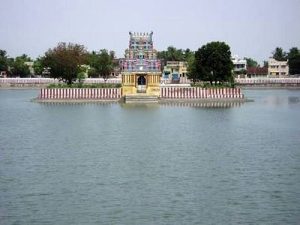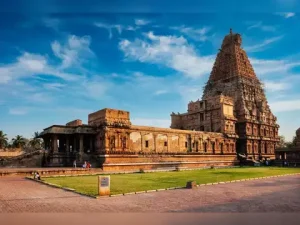Tanjore..
Adirampattinam

Adirampattinam is a municipality in the Pattukottai taluk of the Thanjavur district in the Indian state
of Tamil Nadu. It is also known as Adirai in short by the residents. It is the largest coastal town in
the district and fourth largest town in the Thanjavur district.
Adirampattinam is an important coastal town connecting Chennai and Thoothukudi via the ECR.
Adirampattinam is named after Adhi Veera Rama Pandiyan, who was a local chieftain. Arab traders
from Egypt and Yemen landed at the port of Korkai (now Kayalpatnam) in the Pandia Kingdom in the
year 1120 A.D. Some traders migrated here. Adirampattinam was initially called as Sellinagar.
Strong trading connections existed with Yaalpanam, a city in Sri Lanka. There is a strong cultural
connection between Kayalpatnam, Adirampattinam and Kilakarai.
In 2021, the government upgraded Adirampattinam to municipality status.
Brihadisvara Temple
Brihadisvara Temple
Brihadishvara Temple, called Rajarajesvaram (lit. ‘Lord of Rajaraja’) by its builder, and known locally
as Thanjai Periya Kovil (lit. ‘Thanjavur Big Temple’) and Peruvudaiyar Kovil,
The original monuments of this 11th-century temple were built around a moat. It included gopura,
the main temple, its massive tower, inscriptions, frescoes, and sculptures predominantly related to
Shaivism, but also of Vaishnavism and Shaktism. The temple was damaged in its history and some
artwork is now missing. Additional mandapam and monuments were added in the centuries that
followed. The temple now stands amidst fortified walls that were added after the 16th century.

Punnainallur Mariamman Temple
The Punnai Nallur Mariamman Temple, temple of goddess Mariamman, is a Hindu temple located
at Punnainallur near Thanjavur in the state of Tamil Nadu, India.
[1][2][3] Situated on the outskirts of
Thanjavur, Punnainallur popularly known as Thanjavur Mariamman Kovil has derived considerable
importance from time immemorial in both legend and history. The temple attracts thousands of
devotees from all parts of the district throughout the year. Thanks to the munificence of its
devotees, the temple has been given a facelift in the recent past.

The temple, facing east, has three prakarams. It occupies an area of about one acre, It has a 90 feet
high Rajagopuram, which is comparatively of recent origin. There are several mandapams here viz.,
the Arthamandapam, Mahamandapam, Narthanamandapam, Dwajamandapam,
Alankaramandapam and the Thirumalaipathimandapam. There are in the temple paintings of the
different forms of Ashta Sakthi viz., Gajalakshmi, Veera Lakshmi, Sowbhagya Lakshmi, Santhana
Lakshmi, Dhana Lakshmi, Dhanya Lakshmi, Vidhya Lakshmi and Karunya Lakshmi. The
Sukravaramandapam in the Amman Sannadhi has beautifully carved pillars. The Sthala Viruksham
of the temple is “Vembu” (i.e., Neem Tree) and the sacred Theertham is Mani Muktha Nadhi
(Vadavar River). The presiding deity of this shrine, Goddess Mariamman, is represented by anidol
Legend made of sand over anani-hill and covered with a
silver kavacham.
Thanjavur painting
Thanjavur painting is a classical South Indian painting style, originating from the town of Thanjavur
(anglicized as Tanjore) in Tamil Nadu. The art form draws its immediate resources and inspiration
from way back about 1600 AD, a period when the Nayakas of Thanjavur under the suzerainty of the
Vijayanagara Rayas encouraged art—chiefly, classical dance and music—as well as literature, both in
Telugu and Tamil and painting of chiefly Hindu religious subjects in temples. However, it can safely
be surmised that Thanjavur painting, as we know it now, originated in the Maratha court of
Thanjavur (1676–1855).
[1]
It has been recognized as a Geographical indication by the Government
of India in 2007–08.
[2]
Thanjavur paintings are characterised by rich and vivid colours, simple iconic composition, glittering
gold foils overlaid on delicate but extensive gesso work and inlay of glass beads and pieces or very
rarely precious and semi-precious gems. In Thanjavur paintings one can see the influence of
Deccani, Vijayanagara, Maratha and even European or Company styles of painting. Essentially
serving as devotional icons, the subjects of most paintings are Hindu gods, goddesses, and saints.
Episodes from Hindu Puranas, Sthala-puranas and other religious texts were visualised, sketched or
traced and painted with the main figure or figures placed in the central section of the picture (mostly
within an architecturally delineated space such as a mantapa or prabhavali) surrounded by several
subsidiary figures, themes and subjects. There are also many instances when Jain, Sikh, Muslim,
other religious and even secular subjects were depicted in Tanjore paintings

